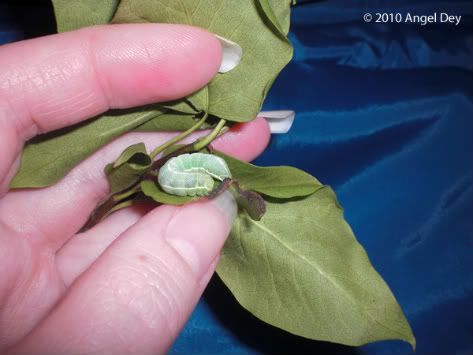At lunch every day I take a walk on the public lands nearby to enjoy nature's majesty. One day a couple of weeks ago I saw this hairy little caterpillar running quickly along the ground. I didn't hesitate to pick him up and take him home. I knew my son would find him fascinating and while we did raise a caterpillar once before, it couldn't hurt to see the magic again. It would be a wonderful educational experience, I thought.
Apparently we got lucky with the last caterpillar we raised. He was easy to find food for even though I didn't know what he was. He ate, he pooped, he cocooned, he emerged and we marveled at his wonder.
This new little guy I found – we named him George – refused be so easy to care for.
After much Internet searching (finally found something close on What's That Bug), I discovered George was in the Buck Moth family. I probably shouldn't have picked him up because he supposedly stings. I didn't discover that first hand thankfully.
I also learned (for future reference) that I should wait for caterpillars to find a plant to munch on if they are just running about because they are very picky about their diets. Specific caterpillar species desire specific plants for various reasons. The monarch prefers plants from the milkweed family because it makes them poisonous. Buck moths are a very large family and different ones prefer different plants. I assumed George is a Nevada Buck Moth only because I live in Nevada. I gathered a bunch of stems from plants I found on my walk, but he never really ate any of it. I later learned Nevada Buck Moths prefer cottonwood and willow, which can't be found anywhere on the lands I usually walk on. I gave him cottonwood leaves but he didn't seem interested. I thought maybe George isn't a Nevada Buck Moth but some other Buck Moth. I saw him chewing on a branch of the sage brush I picked once, so I gave him more of that.
I also learned caterpillars should NEVER go without food at all or it will weaken their immune systems. George had gone days without eating and I felt sure I doomed the little guy. I felt really, really bad. However, the sage brush was with him the whole time, so it was his own fault for not eating, not mine.
Luckily, I learned his lack of eating and his running laps in the enclosure meant he was in the "getting ready to pupate" stage and he was looking for a place to hide. I found out that Buck Moths prefer to dig a little indent in the dirt rather than hook themselves to a tree branch and make a cocoon. So I put some desert dirt in his enclosure and George immediately started digging. I felt extremely relieved that maybe I hadn't doomed him after all. I still felt guilty for taking so long to figure that out.
After a few days of just laying on the dirt, not moving (unless I poked him) and not eating, I was really starting to worry. I didn't want George to die due to my caterpillar ignorance, and I especially didn't want to tell my son he had died because I wasn't being a responsible caterpillar caretaker. I admit, that's selfish of me, but that's what I was feeling.
I checked on him every day and waited and hoped. It was all I could do. At long last George molted and became a pupa. I was so excited. My son was excited. My friends and co-workers were excited. Success!

And now we wait some more. Apparently Buck Moths stay in the pupa stage until fall. But at least George got to that stage without dying. I'm very happy about that.
I also told my son everything I learned along the way. I may have been a horrible caterpillar caretaker, but now we know what we are supposed to do next time we decide to foster a critter: Learn before you leap.
And then we found Larry.

I don't know what kind of caterpillar he is, but I do know what he likes to eat.
Help your children learn more about caterpillars with the National Geographic book Face to Face with Caterpillars.


No comments:
Post a Comment